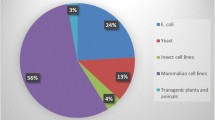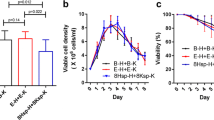Abstract
As a tool for large scale production of recombinant proteins, chickens have advantages such as high productivity and low breeding costs compared to other animals. We previously reported the production of erythropoietin, the tumor necrosis factor receptor fused to an Fc fragment, and an Fc-fused single-chain Fv antibody in eggs laid by genetically manipulated chickens. In egg white, however, the incomplete addition of terminal sugars such as sialic acid and galactose was found on N-linked glycans of exogenously expressed proteins. This could be a draw back to the use of transgenic chickens since the loss of these terminal sugars may affect the functions and stability of recombinant proteins purified from chicken egg white for pharmaceutical usage. To overcome this problem, we studied galactosyltransferase (GalT) activity in the magnum where the majority of egg-white proteins are secreted. In the magnum, lower β1,4-GalT1 expression and poor galactose-transfer activity were observed. Thus, we supposed that the lack of GalT1 activity may partly cause the incomplete glycosylation of egg-white proteins, and generated genetically manipulated chickens expressing GalT1 by retrovirus-mediated gene transfer. In a Golgi fraction prepared from magnum cells of the genetically manipulated chickens, significant GalT activity was detected. The series of analyses revealed a considerable improvement in the galactosylation of native egg-white proteins as well as an exogenously expressed single-chain Fv antibody fused to an Fc fragment. We conclude that chickens with genetically modified GalT activity in the magnum could be an attractive platform for producing galactosylated therapeutics.





Similar content being viewed by others
References
Bergeron JJM, Ehrenreich JH, Siekevitz P, Palade GE (1973) Golgi fractions prepared from rat liver homogenates. II. Biochemical characterization. J Cell Biol 59:73–88
Chiba Y, Akeboshi H (2009) Glycan engineering and production of ‘humanized’ glycoprotein in yeast cells. Biol Pharm Bull 32:786–795
Colley KJ (1997) Golgi localization of glycosyltransferases: more questions than answers. Glycobiology 7:1–13
Da Silva MLC, Stubbs HJ, Tamura T, Rice KG (1995) 1H NMR characterization of a hen ovalbumin tyrosinamide N-linked oligosaccharide library. Arch Biochem Biophys 318:465–475
Davies J, Jiang L, Pan L-Z, LaBarre MJ, Anderson D, Reff M (2001) Expression of GnTIII in a recombinant anti-CD20 CHO production cell line: expression of antibodies with altered glycoforms leads to an increase in ADCC through higher affinity for FcγRIII. Biotechnol Bioeng 74:288–294
Ferrara C, Brünker P, Suter T, Moser S, Püntener U, Umaña P (2006) Modulation of therapeutic antibody effector functions by glycosylation engineering: influence of Golgi enzyme localization domain and co-expression of heterologous β1,4-N-acetylglucosaminyltransferase III and Golgi α-mannosidase II. Biotechnol Bioeng 93:851–861
Hodoniczky J, Zheng YZ, James DC (2005) Control of recombinant monoclonal antibody effector functions by Fc N-glycan remodeling in vitro. Biotechnol Prog 21:1644–1652
Hotta A, Saito Y, Kyogoku K, Kawabe Y, Nishijima K, Kamihira M, Iijima S (2006) Characterization of transient expression system for retroviral vector production. J Biosci Bioeng 101:361–368
Imai-Nishiya H, Mori K, Inoue M, Wakitani M, Iida S, Shitara K, Satoh M (2007) Double knockdown of α1,6-fucosyltransferase (FUT8) and GDP-mannose 4,6-dehydratase (GMD) in antibody-producing cells: a new strategy for generating fully non-fucosylated therapeutic antibodies with enhanced ADCC. BMC Biotechnol 7:84
Jefferis R (2009) Glycosylation as a strategy to improve antibody-based therapeutics. Nat Rev Drug Discov 8:226–234
Kamihira M, Ono K, Esaka K, Nishijima K, Kigaku R, Komatsu H, Yamashita T, Kyogoku K, Iijima S (2005) High-level expression of single-chain Fv-Fc fusion protein in serum and egg white of genetically manipulated chickens by using a retroviral vector. J Virol 79:10864–10874
Kamihira M, Kawabe Y, Shindo T, Ono K, Esaka K, Yamashita T, Nishijima K, Iijima S (2009) Production of chimeric monoclonal antibodies by genetically manipulated chickens. J Biotechnol 141:18–25
Kawabe Y, Kamihira M, Ono K, Kyogoku K, Nishijima K, Iijima S (2006) Production of scFv-Fc fusion protein using genetically manipulated quails. J Biosci Bioeng 102:297–303
Kodama D, Nishimiya D, Iwata K, Yamaguchi K, Yoshida K, Kawabe Y, Motono M, Watanabe H, Yamashita T, Nishijima K, Kamihira M, Iijima S (2008) Production of human erythropoietin by chimeric chickens. Biochem Biophys Res Commun 367:834–839
Kyogoku K, Yoshida K, Watanabe H, Yamashita T, Kawabe Y, Motono M, Nishijima K, Kamihira M, Iijima S (2008) Production of recombinant tumor necrosis factor receptor/Fc fusion protein by genetically manipulated chickens. J Biosci Bioeng 105:454–459
Lee PL, Kohler JJ, Pfeffer SR (2009) Association of β-1,3-N-acetylglucosaminyltransferase 1 and β-1,4-galactosyltransferase 1, trans-Golgi enzymes involved in coupled poly-N-acetyllactosamine synthesis. Glycobiology 19:655–664
Lillico SG, Sherman A, McGrew MJ, Robertson CD, Smith J, Haslam C, Barnard P, Radcliffe PA, Mitrophanous KA, Elliot EA, Sang HM (2007) Oviduct-specific expression of two therapeutic proteins in transgenic hens. Proc Natl Acad Sci USA 104:1771–1776
Lopez LC, Youakim A, Evans SC, Shur BD (1991) Evidence for a molecular distinction between Golgi and cell surface forms of β1,4-galactosyltransferase. J Biol Chem 266:15984–15991
Motono M, Yamada Y, Hattori Y, Nakagawa R, Nishijima K, Iijima S (2010) Production of transgenic chickens from purified primordial germ cells infected with a lentiviral vector. J Biosci Bioeng 109:315–321
Padler-Karavani V, Yu H, Cao H, Chokhawala H, Karp F, Varki N, Chen X, Varki A (2008) Diversity in specificity, abundance, and composition of anti-Neu5Gc antibodies in normal humans: potential implications for disease. Glycobiology 18:818–830
Raju TS (2008) Terminal sugars of Fc glycans influence antibody effector functions of IgGs. Curr Opin Immunol 20:471–478
Raju TS, Briggs JB, Borge SM, Jones AJS (2000) Species-specific variation in glycosylation of IgG: evidence for the species-specific sialylation and branch-specific galactosylation and importance for engineering recombinant glycoprotein therapeutics. Glycobiology 10:477–486
Raju TS, Briggs JB, Chamow SM, Winkler ME, Jones AJS (2001) Glycoengineering of therapeutic glycoproteins: in vitro galactosylation and sialylation of glycoproteins with terminal N-acetylglucosamine and galactose residues. Biochemistry 40:8868–8876
Schaub BE, Berger B, Berger EG, Rohrer J (2006) Transition of galactosyltransferase 1 from trans-Golgi cisterna to the trans-Golgi network is signal mediated. Mol Biol Cell 17:5153–5162
Schmitz KR, Liu J, Li S, Setty TG, Wood CS, Burd CG, Ferguson KM (2008) Golgi localization of glycosyltransferases requires a Vps74p oligomer. Dev Cell 14:523–534
Schuster M, Jost W, Mudde GC, Wiederkum S, Schwager C, Janzek E, Altmann F, Stadlmann J, Stemmer C, Gorr G (2007) In vivo glyco-engineered antibody with improved lytic potential produced by an innovative non-mammalian expression system. Biotechnol J 2:700–708
Sethuraman N, Stadheim TA (2006) Challenges in therapeutic glycoprotein production. Curr Opin Biotechnol 17:341–346
Shaper NL, Meurer JA, Joziasse DH, Chou T-DD, Smith EJ, Schnaar RL, Shaper JH (1997) The chicken genome contains two functional nonallelic β1,4-galactosyltransferase genes. Chromosomal assignment to syntenic regions tracks fate of the two gene lineages in the human genome. J Biol Chem 272:31389–31399
Shields RL, Lai J, Keck R, O’Connell LY, Hong K, Meng YG, Weikert SHA, Presta LG (2002) Lack of fucose on human IgG1 N-linked oligosaccharide improves binding to human FcγRIII and antibody-dependent cellular toxicity. J Biol Chem 277:26733–26740
Shinkawa T, Nakamura K, Yamane N, Shoji-Hosaka E, Kanda Y, Sakurada M, Uchida K, Anazawa H, Satoh M, Yamasaki M, Hanai N, Shitara K (2003) The absence of fucose but not the presence of galactose or bisecting N-acetylglucosamine of human IgG1 complex-type oligosaccharides shows the critical role of enhancing antibody-dependent cellular cytotoxicity. J Biol Chem 278:3466–3473
Strasser R, Castilho A, Stadlmann J, Kunert R, Quendler H, Gattinger P, Jez J, Rademacher T, Altmann F, Mach L, Steinkellner H (2009) Improved virus neutralization by plant-produced anti-HIV antibodies with a homogeneous β1,4-galactosylated N-glycan profile. J Biol Chem 284:20479–20485
Takeuchi M, Kobata A (1991) Structures and functional roles of the sugar chains of human erythropoietins. Glycobiology 1:337–346
Teasdale RD, Matheson F, Gleeson PA (1994) Post-translational modifications distinguish cell surface from Golgi-retained β1,4 galactosyltransferase molecules. Golgi localization involves active retention. Glycobiology 4:917–928
Tsuchiya N, Endo T, Matsuta K, Yoshinoya S, Aikawa T, Kosuge E, Takeuchi F, Miyamoto T, Kobata A (1989) Effects of galactose depletion from oligosaccharide chains on immunological activities of human IgG. J Rheumatol 16:285–290
Tu L, Tai WCS, Chen L, Banfield DK (2008) Signal-mediated dynamic retention of glycosyltransferases in the Golgi. Science 321:404–407
Umaña P, Jean-Mairet J, Moudry R, Amstutz H, Bailey JE (1999) Engineered glycoforms of an antineuroblastoma IgG1 with optimized antibody-dependent cellular cytotoxic activity. Nat Biotechnol 17:176–180
Vleurick L, Kühn ER, Decuypere E, Van Veldhoven PP (1999) Isolation of plasma membranes and Golgi apparatus from a single chicken liver homogenate. J Cell Biochem 72:349–355
Yamane J, Kubo A, Nakayama K, Yuba-Kubo A, Katsuno T, Tsukita S, Tsukita S (2007) Functional involvement of TMF/ARA160 in Rab6-dependent retrograde membrane traffic. Exp Cell Res 313:3472–3485
Zhu L, van de Lavoir M-C, Albanese J, Beenhouwer DO, Cardarelli PM, Cuison S, Deng DF, Deshpande S, Diamond JH, Green L et al (2005) Production of human monoclonal antibody in eggs of chimeric chickens. Nat Biotechnol 23:1159–1169
Acknowledgments
We thank Dr. T. Yoshimura, Graduate School of Bioagricultural Sciences, Nagoya University for the frozen sections. This work was supported by the Program for Promotion of Basic Research Activities for Innovative Biosciences (PROBRAIN).
Author information
Authors and Affiliations
Corresponding author
Electronic supplementary material
Below is the link to the electronic supplementary material.
11248_2011_9511_MOESM1_ESM.pdf
Supplemental Fig. 1 (a) Intracellular localization of chicken GalTs was analyzed by immunostaining. FLAG-tagged chicken GalTs were transiently expressed in Hela cells. GalTs were stained using anti-FLAG M2 antibody and TRITC-conjugated secondary antibody (red), and nuclei were counterstained with DAPI (blue). (b) Confocal microscopic immunofluorescence images of Hela cells that expressed GalT1-FLAG or GalT1-KDEL-FLAG. Endoplasmic reticulum retention signal KDEL sequence was attached at the C-terminal of GalT1 by PCR. After transfection of expression plasmids, cells were immunostained using anti-FLAG M2 antibody and FITC-conjugated secondary antibody. Z-stack images are shown (PDF 172 kb)
11248_2011_9511_MOESM2_ESM.pdf
Supplemental Fig. 2 (a, b) Average copy numbers of the integrated viral vector in blood cell (a) and magnum tissue (b) were measured by quantitative PCR for eGFP. *, not detected; WT, wild-type chicken. (c) Relative GalT1 mRNA amounts in the magnum of GM chickens. GAPDH mRNA was used for normalization and the results are represented as relative values against the amount of GalT1 mRNA in wild-type (WT) chicken. (d) Protein G-purified scFvFcs produced by GalT1-GM chickens were treated with or without β-galactosidase, then, subjected to RCA120 lectin blotting. scFvFc from transgenic chicken expressing scFvFc alone (Kamihira et al. 2005) was used as a control. Anti-Fc antibody was used for detection of the total amount of scFvFcs (PDF 53 kb)
Rights and permissions
About this article
Cite this article
Mizutani, A., Tsunashima, H., Nishijima, Ki. et al. Genetic modification of a chicken expression system for the galactosylation of therapeutic proteins produced in egg white. Transgenic Res 21, 63–75 (2012). https://doi.org/10.1007/s11248-011-9511-0
Received:
Accepted:
Published:
Issue Date:
DOI: https://doi.org/10.1007/s11248-011-9511-0




